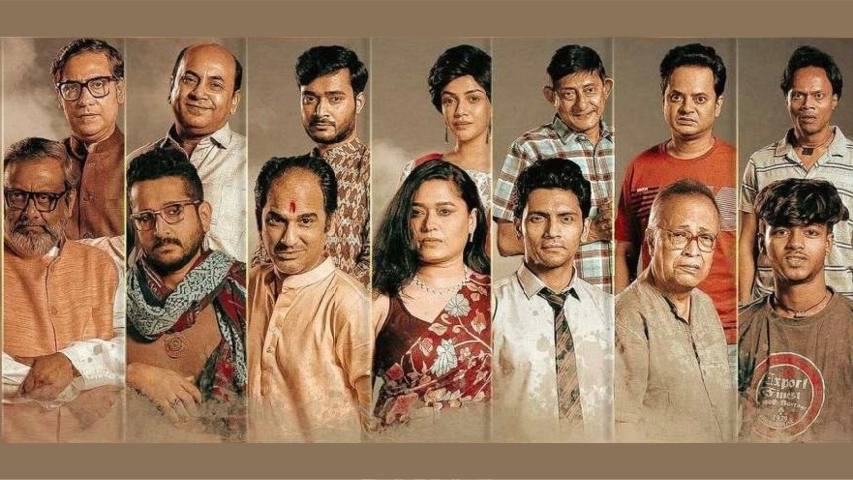
ALTERNATIVE ENTERTAINMENT: REIMAGINING 12 ANGRY MEN
by Shantanu Ray Chaudhuri February 28 2025, 12:00 am Estimated Reading Time: 8 mins, 14 secsSrijit Mukherji’s Shotyi Bole Shotyi Kichhu Nei reinvents 12 Angry Men with a fresh, outdoor setting, gender perspectives, and a gripping narrative, proving its timeless relevance in 2025’s India. Shantanu Ray Chaudhuri reviews the film, giving it full marks.
Srijit Mukherji’s Shotyi Bole Shotyi Kichhu Nei is a bold reimagining of 12 Angry Men, breaking free from its one-room setting to explore themes of privilege, gender, and societal bias in contemporary India. With stellar performances by Parambrata Chatterjee and Ritwik Chakraborty, the film captivates with its unique locations—from beaches to golf courses—symbolizing the complexities of justice. Mukherji’s adaptation introduces a feminine perspective and challenges deep-seated prejudices, making it a must-watch. This modern take on Reginald Rose’s classic legal drama proves that its themes remain as relevant in 2025 as they were in 1950s America.
A Risky Undertaking
It takes gumption to go out on a limb like this. As I watched the trailer and teaser of Shotyi Bole Shotyi Kichhu Nei, I despaired. What were the jurors doing on beaches and road dividers? The searing drama of 12 Angry Men worked primarily because of the film’s unique setting—twelve disparate people on edge, holed up in a single room on a stiflingly humid day, with rainclouds threatening to break but never doing so, as that would offer a release to the pent-up angst that informs their interactions. And how creatively Sidney Lumet makes use of the constrained space so that not a single shot is repeated from the same POV over the course of its runtime.
The claustrophobia of the setting, the people wiping the sweat off their faces even as they chafe at the bit and go hammer and tongs at each other. Even Basu Chatterjee’s Ek Ruka Hua Faisla, which Srijit’s opening titles mention as the source for his film, adhered strictly to the template of the original. As Srijit clarifies, “That’s because I was introduced to this template by Ek Ruka Hua Faisla. I had put this project on the backburner and revived it only recently when I heard that Ek Ruka Hua Faisla was being remade in Mumbai. So, I contacted the makers and took the rights, as the script was lying with me for the longest time.”
Also, 12 Angry Men and its many adaptations and remakes continue to resonate so deeply that I wondered what a filmmaker would bring to it in 2025 that is new, that offers a different perspective. As Srijit says, “Yes, it’s a classic template… as a storyteller, I was tempted to use that to narrate a story of conflicting ideas, prejudices, and biases—human psychology being exposed under the guise of a legal drama. It can be placed in any time period.” But there’s a rub.

Reinventing the Classic
Ek Ruka Hua Faisla was more or less a shot-for-shot copy of 12 Angry Men, without the intelligence to address the fact that the jury system had been abolished in the Indian judiciary in 1973, in the aftermath of the Nanavati case, which “sparked intense public debate” and highlighted the “difficulties of the jury system in a multicultural, multilingual, and multiethnic Indian society.” It offered nothing new, nor did William Friedkin’s made-for-television remake in 1997. The source material is so powerful, and the array of actors on display so brilliant, that most adaptations pass muster on the strength of those even when they have little to add. What had Srijit conjured?
I needn’t have worried. From the get-go, Shotyi is a dazzling accomplishment. A director at the top of his game, taking on a veritable all-time classic of cinema and giving it his own stamp. Most importantly, this is not just another remake or copy of 12 Angry Men. Srijit takes the kernel of the plot from Reginald Rose’s play and makes it a beast of his own. He also works out a neat little ploy to take care of the fact that the jury system is not operational in India. He masks the narrative device that enables this so well that it’s only in post-watching reflection that you realize the sheer ingenuity of it.
He also does what none of the other cinematic adaptations of 12 Angry Men have attempted—introducing a feminine perspective into the deliberations by making two of the jurors women. That not only enables the screenplay to incorporate gender issues, but also gives the narrative a frisson, thanks to the rather tetchy interactions between the two women that demonstrate how a woman need not always be another woman’s best friend. They are as much at loggerheads with each other and as judgmental about their lifestyle choices as a male chauvinist might be about a woman.
Video 1
https://www.youtube.com/watch?v=GgQQdI9PELE
Which brings us to the most startling change Shotyi makes to the original. Talking about opening the play up to the outdoors, Srijit says, “I thought it would be a greater challenge to maintain the claustrophobia in open spaces. I also wanted it to be set in the mind space of a single decision-maker, and how that one dream pertaining to the case interacts with various memories he has.”
In freeing the play from the confines of its one-room setting and taking it to a golf course, a road divider on a flyover, a beach, a forest, Srijit dismantles the original. However, instead of the tension of the original getting dissipated, it opens the narrative up to many interpretations for those so inclined. The golf course, for example, might be said to symbolize privilege and power, reflecting how some characters come from elite backgrounds, which influences their perspectives on justice. It also represents strategy and calculated decisions, much like the jury’s deliberation.
The theatre represents performance, drama, and the masks people wear in society. It highlights how jurors (and people in general) express their opinions, argue their points, and sometimes even pretend to believe in something they don’t fully support. A road divider on a bridge in the middle of the city could stand for transition, connection, and uncertainty. It represents a crossing point in a mental or emotional journey, much like standing on a bridge before deciding which path to take. The jungle reflects the complexity of the case. Just like in a dense forest, the truth is difficult to see, and one must carefully navigate through conflicting perspectives. The seashore stands for reflection, emotional release, and the passage of time. It represents letting go of past trauma, as seen in the moment of emotional breakdown and healing as experienced by one of the women jurors.
A Bold New Approach
In a major departure from the original, where the perspective of the crime comes through the jurors deliberating on what might have happened (to keep the sanctity of the location), in Srijit’s film, the action opens up to reveal the world beyond. The opening up of the locations goes hand in hand with the opening up of the perspectives of the dramatis personae.
It goes without saying that an enterprise like this would not work if the technical crew didn’t measure up to the director’s vision. The film benefits immensely from its terrific production and sound design (just consider the sound of breaking glass with which the narrative takes off, symbolizing the blurred line between reality and dreams). The crafting of each locale for the jury’s deliberations is the film’s highlight, and it is in these sequences that Prosenjit Chowdhury’s cinematography and Sanglap Bhowmik’s editing leave a lasting impression. The framing is meticulous and enables multiple strands to coexist in a single shot. I particularly liked the director’s take in having parts of the action play out in the background of the jurors’ deliberations so that multiple parts of the screen call for your attention.
With a star cast that boasts the who’s who of the industry, it is no surprise that the performances are top-notch. And importantly, despite the presence of twelve stalwarts, each gets a piece of the action that justifies their presence in the narrative. Though that makes it difficult to single out a particular actor or two for the acting honours, my vote goes to Parambrata Chatterjee and Ritwik Chakraborty. It’s good to see Param getting a character he can bite into, and he does full justice to it, reining himself in admirably in a role that must have been tempting enough to play to the gallery. He brings back memories of one of his finest performances in Samantaral, though the latter was understandably more understated. Ritwik literally burns the screen with his take on the uncouth and foul-mouthed man who can barely keep his bigotry under wraps. He is frighteningly real. The others are as good—Rahul Banerjee in particular—while Anirban Chakravarti and Sauraseni Maitra (what a pleasure it is to see her back among the stars after a long time) make the most of the film’s telling sequence at the seashore, where Sauraseni revisits her childhood trauma before finally breaking down. As the waves rise and recede in the background, she finds the strength to move toward something approximating closure.
One of Srijit’s many triumphs is the way he makes the film not about the original crime of the murder, which becomes incidental, but about the prejudices that seemingly educated, civilized people nurture. Shotyi Bole Shotyi Kichhu Nei proves that Reginald Rose’s 12 Angry Men is indeed timeless—just as contemporary in India 2025 as it was in 1950s America.





-173X130.jpg)
-173X130.jpg)
-173X130.jpg)
-173X130.jpg)
-173X130.jpg)
-173X130.jpg)
-173X130.jpg)
-173X130.jpg)